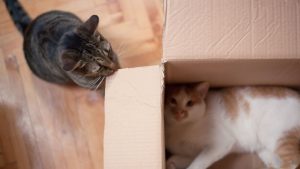Moving House with a Cat? Your Guide to a Stress-Free Transition
Table of Contents
Moving house can be an exciting and stressful time, especially when you have a furry friend to consider, but moving with a cat doesn’t have to be a cat-astrophe.
Cats are creatures of habit, and the idea of packing up their cosy and comfortable surroundings can leave them feeling confused, anxious, and a bit moody. But with a little preparation and patience, you and your feline companion can make the transition to your new home stress- (and claw-) free.
In this blog, we’ll share tried-and-tested tips from fellow feline-lovers, as well as a step-by-step guide to make your cat’s move as smooth as possible, from preparing your cat for the big day to settling them into their new environment. Let’s get started!
How Do You Move House with a Cat?
There are a lot of unknowns when it comes to moving house with cats; How will they react to your new home? Will they get on with the other cats in the neighbourhood? What if they try to escape?
These are all normal questions to be asking, and it’s important to ensure you and your fur child are best prepared for the challenges that might come with this new adventure.
Moving with an outdoor cat can be very different than an indoor one, and the same applies to kittens. Here’s how you can make the transition stress-free for these different kitties.
Indoor Cats
Indoor cats are generally less accustomed to changes in their environment and may take longer to adapt to new surroundings. To prepare your indoor cat for the move, start by creating a safe and secure space for them in your new home. This can be a room that is free from boxes and other clutter where your cat can explore and get comfortable.
Be sure to include familiar items such as their bed, litter box, and toys. When it’s time to transport your cat to the new home, use a secure carrier and provide plenty of water, food, and litter for the big journey.
Outdoor Cats
On the other hand, outdoor cats are generally more adaptable to new environments, so the move might not be as much of a disruption. Nonetheless, it’s still important to take some precautions to ensure their safety during the move.
Start by keeping your cat indoors for a few weeks before the move to allow them to get used to being inside. Make sure your cat has a secure carrier for the journey, and consider micro-chipping them if you haven’t already.
Once you arrive at your new home, keep your outdoor cat indoors for a few days before letting them explore the new area. This will give them time to adjust to their new surroundings and reduce the risk of them running away. It’s also a good idea to do some exploring with them until they feel comfortable in their new environment and know their way back home.
Kittens
Moving house with a kitten can be particularly challenging as they are still finding their feet in their current surroundings. To prepare your kitten for the move, start by familiarising them with their carrier and the car. If you can, take short trips with your kitten to help them get used to the experience.
Once in your new home, create a safe and familiar space for your kitten. Allow them to explore their new surroundings gradually, starting with their designated area and then expanding their access over time. This will help your kitten feel more secure and less overwhelmed during the transition.
It’s important to update your kitten’s information with your new address and contact details, as well as ensuring they have proper identification, such as a collar and tag, or a microchip.
What to do When You Move House with a Cat
Before the Move
- Chat to your vet: Take your feline friend to the vet before you move to ensure they’re healthy and up-to-date on their vaccinations. If you have an over-anxious cat, this is also a good time to talk about possible sedatives to make the journey less stressful.
- Find a comfy carrier: If you already have one they like, even better. But if you don’t, pick a carrier that’s cosy and secure. Let them explore it and gradually introduce them to it by placing their favourite blanket or toy inside.
- Update their ID: Make sure your cat’s identification has your latest contact details, including your new address.
- Choose your transportation: Decide on the best transportation method for your cat. If you’re driving, plan regular breaks and a comfy resting spot for them. If you’re using a pet transport service, do your research and choose a trustworthy company.
- Pack their essentials: Keep all of your cat’s must-haves like food, water, litter box, and toys in a separate bag or box that’s easily accessible. This way, you’ll have everything you need for your cat during the move.
On Move Day
- Place them in a designated room: During the move, keep your cat in a safe room with all their essentials and stick a note on the door to remind others not to open it.
- Keep them fed and hydrated: Make sure your cat has access to food, water, and a litter box while they’re in their carrier. This will help them stay comfortable and avoid unnecessary stress.
- Check on your cat regularly: Throughout the move, check on your cat regularly to ensure they’re comfortable and calm. Offer them some treats or play with them to help keep them relaxed.
- Use calming pheromones: You can spray calming pheromones in your cat’s carrier to help them feel more relaxed and calm during the move.
- Provide familiar items: Your cat may find the move more comfortable if they have familiar items around them, such as blankets or toys. Place these in their carrier to help them feel more at home.
After the Move
- Create a safe and secure space: Once you arrive at your new home, create a little haven for your cat. Choose a quiet room where they won’t be disturbed, and fill it with all of your cat’s essentials, such as food, water, litter box, and toys.
- Introduce your cat gradually: After your cat has settled into their safe space, gradually introduce them to the rest of the home. Start with one room at a time and let your cat explore at their own pace. Provide lots of positive reinforcement and treats to help them feel comfortable.
- Keep your cat indoors: For the first few weeks, it’s important to keep your cat indoors to prevent them from getting lost or disoriented.
- Watch for signs of stress: Moving can be stressful for cats, so keep an eye out for signs of stress such as hiding, excessive grooming, or changes in appetite. If you notice any concerning behaviours, consult with your vet for advice on how to help your cat adjust.
- Maintain their routine: Try to maintain your cat’s routine as much as possible, including feeding times and playtime. This will help them feel more secure and establish a sense of normalcy in their new home.
- Give them extra attention: Moving can be a big adjustment for your cat, so make sure to give them plenty of extra attention, playtime, and snuggles during the transition.
Moving House with a Cat: Butter on Paws Debunked
Putting butter on your cat’s paws is a common piece of advice that some pet owners follow. Many believe that the butter will have a soothing effect on their cat and distract it from its unfamiliar surroundings. However, there is no scientific evidence that supports this, and it is unlikely to be effective.
In fact, most cats will simply shake off the butter or become more anxious by having their paws smeared with it. It is important to understand that cats rely heavily on their sense of smell and familiarity with their environment to feel secure. So, gradually introducing them to the new surroundings and giving them a safe space to adjust is a better approach to help them settle into their new home.
Tips for Moving House with a Cat
- Create a “cat box” with items that have your cat’s scent to help them feel comfortable.
- Spread your cat’s scent throughout the house by rubbing a cotton cloth gently on her cheeks and head to collect the scent from glands around their face.
- Consider using diffusers to help reduce your cat’s anxiety.
- Maintain your cat’s routine as much as possible.
- Allow your cat to explore the new home at their own pace and offer positive reinforcement.
- Watch for signs of stress and adjust your approach if needed.
- Give your cat plenty of attention and comfort during the transition.
- Keep your cat indoors for at least two weeks after the move to avoid them getting lost or disoriented.
It’s true that moving house with cats in Ireland is no walk in the park. But with preparation, patience, and lots of love, your fur child will be purring again in no time.
Let Nesta Make Your Move Purr-fectly Easy
Need more guidance to reduce the stress of a house move? Our moving house checklist should help make the transition as smooth as possible.
If you need additional help during the move, Nesta offers, quality packaging supplies and convenient self storage solutions throughout Dublin to make the transition even smoother.
Call us on 1800 77 22 33, or request a quote today to learn more about our services and how we can assist you during your move.
Table of Contents
Related Posts
- December 11, 2025|1 min read
- December 8, 2025|4 min read
- November 27, 2025|1 min read











